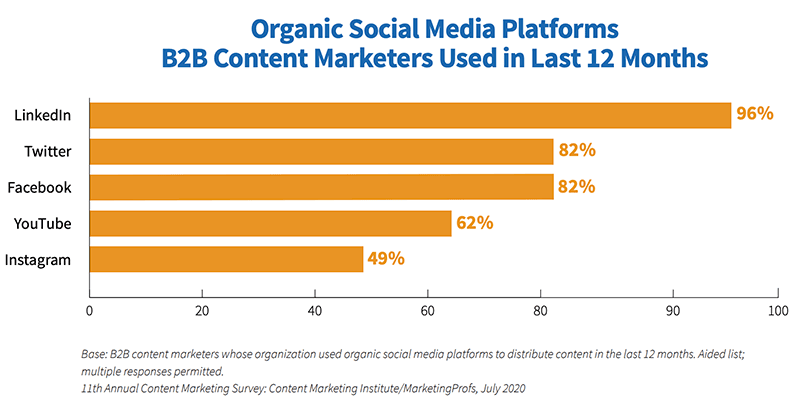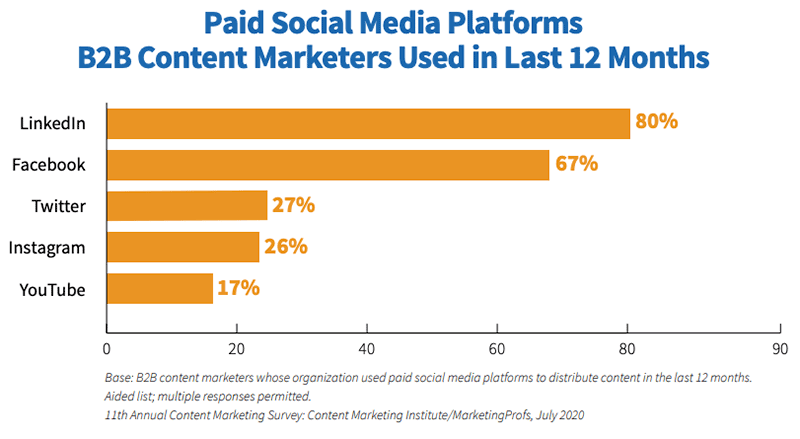Most brands today leverage social media as a channel for content distribution and a place to build a community. And while there are many platforms out there, LinkedIn continues to corner the market on business-centric content, industry-centric groups, and professional networking. So, if these avenues of social media usage fit the best for your company, what’s the secret recipe for creating successful LinkedIn posts? There’s no definitive answer, but we’re breaking down the impact of LinkedIn and how you can master post writing to drive engagement.
The State of LinkedIn
Before we start on how to write compelling LinkedIn posts, it’s important to understand the data behind the success of the platform.
-
- Users trust LinkedIn above other social media sites. In a survey that looked at five trust factors: security, legitimacy, community, ad experience, and ad relevance, LinkedIn ranked the highest. It far outperforms Facebook and Twitter.
- Content creation is booming on the site, increasing 60 percent in 2020. More content generally aligns with trends relating to the desire for it.
- It’s a place for employee advocacy. Employees are 14x more likely to share a LinkedIn post from their company than any other content type. Engaging your staff is essential to expanding your reach and engagement, and LinkedIn is the site to capitalize on this.
- Visuals matter in posts. Posts with images get 2x more engagement, and users are 20x more likely to share video posts.
- LinkedIn ads have excellent returns. They can increase purchase intent by 33 percent and reach 13 percent of the world’s population.
- Your buyers are on LinkedIn. Four out of five people on the site drive business decisions, and the membership includes 61 million senior-level influencers.
- B2B content marketers overwhelmingly prefer it, at a 96 percent use rate. It’s also the most used platform for ads at 80 percent.


Image: CMI
All these data points illustrate the importance of LinkedIn and how both content marketers and buyers use it. Knowing that it has such value and credibility, enterprise content teams need a successful content strategy specific to LinkedIn to ensure it delivers results.
What Should a LinkedIn Content Strategy Contain?
The first thing to consider is what is the purpose of LinkedIn to your company and what kind of goals do you have.
Documenting your goals for the platform will lead to a content plan that considers what you’ll post, how frequently you publish, the tone and voice for posts, and how you’ll measure success with content analytics.
Not having a strategy will likely result in disappointment. You won’t see the engagement or traffic you desire. Let’s break down what a basic LinkedIn strategy should include.
- Purpose and goals: How will you use LinkedIn? In most cases, it’s a content distribution channel. It can also be a lead generator with ads. Further, it’s a place to develop thought leadership, if your leadership posts frequently and shares their perspectives. Additionally, it’s a place to build a community, not just on your page but through groups.
- What to post: Most of your posts should be original content that’s educational and helpful—blogs, ebooks, infographics, videos, etc. However, you should also post third-party content from reputable industry sources like publications, organizations, and partners. Finally, a small portion of your posts should be purely promotional, relating to your products and services.
- How often to post: Social media growth depends on consistency. You can’t be haphazard with posting. Using a content calendar allows you to organize the process. There is no magic number. It will depend on the content you have available and resources. The more you post, the more you’ll learn about when is a good time, which can inform frequency.
- Voice and tone: Most brands have a voice and tone guide. Your voice should be consistent, but your tone can change depending on the channel. Document the style you’ll take in posting that’s true to your brand but will also resonate with audiences in this channel.
- Measuring success: Determine what metrics you need to track to understand performance. Those may include impressions, engagement (likes, shares, comments), followers, traffic to your website, and your reach.
Once you have this strategic foundation, you can focus more on how to write the best LinkedIn posts.
How to Write LinkedIn Posts that Resonate

LinkedIn posts are different from other social media sites in many ways. They are mostly professional, not personal. They tend to be longer than Facebook or other sites. LinkedIn also is more focused on B2B, whereas Instagram and others lean toward B2C.
LinkedIn also shares some similarities with other social networks. For example, there’s an algorithm behind your feed that determines what you see. You can use hashtags. You can post all kinds of content formats. Comments and reactions are also similar to others. However, due to the differences mentioned previously, LinkedIn posts should be different from what you post on other channels.
In our experience, and with input from our content marketing experts, here are the tips we recommend.
- Mention other people and brands: When you post, tag the author of the content from your team, or if it’s a case study, tag your customer. Giving credit and acknowledging the real people behind the brand, can be very engaging.
- Use video: We’ve learned that video is highly shareable. There are lots of options for what type of video, from animated explainers to casual conversations with leaders. Keeping it short is usually a best practice. You’ll need to gather data on the performance to learn what type of video your audience loves. These trends are also shifting in the age of the pandemic where everything’s virtual. Buyers want to consume content to learn about options and solve problems, and they’ll be looking for it on LinkedIn.
- Be emotive: Despite LinkedIn being business-centric, you’re still trying to engage with people. And people connect to emotional content. You can express this in posts by showing empathy, sticking to your values, and reading the room. There are lots of concerning and challenging things happening in the world. Your posts shouldn’t forget that.
- Be relevant: Your posts should take into consideration what’s happening right now. It shows you understand your industry and the most pressing challenges.
- Say something different: This doesn’t mean being controversial exactly, but your brand has a specific point of view. Use that in what and how you post. Don’t fall in line if that’s not who you are.
- Include storytelling: People love stories—they’ll actually read them. If you can set up your posts as a short story that leads users to your website, you will have a much better chance of engaging them.
- Educate your audience: Leading with education first is vital in content marketing, so make sure that it carries over to your posts, whether they are linking to other content or standing alone. Stats, graphs, and data are proof points here.
Getting LinkedIn Posts Right
There is no magic recipe for LinkedIn posting. You’ll need to experiment, measure, and tweak, just like any other channel. Hopefully by building a strategy and following these tips, your efforts will result in an engagement spike. For more great tips, tricks and content marketing insights, subscribing to our blog, written by and for content marketers.